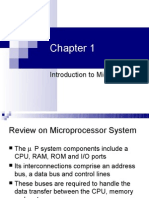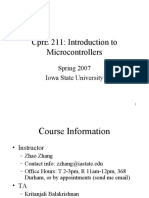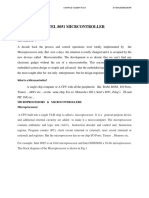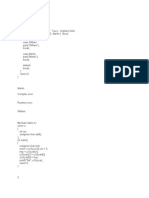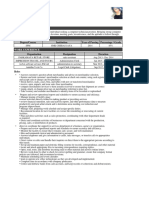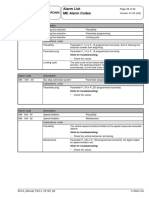lect 4 4/19/2025
•What are Microcontrollers?
Introduction to Microcontrollers
• A microcontroller (MCU) is a small computer on a single
integrated circuit consisting of a relatively simple central
processing unit (CPU) combined with peripheral devices
such as memories, I/O devices, and timers.
• By some accounts, more than half of all CPUs sold worldwide
are microcontrollers
1
lect 4 4/19/2025
Introduction to Microcontrollers
Microcontroller VS Microprocessor
• A microcontroller is a small computer on a single
integrated circuit containing a processor core,
memory, and programmable input/output
peripherals.
• A microprocessor incorporates the functions of a
computer’s central processing unit (CPU) on a
single integrated circuit.
2
lect 4 4/19/2025
Microcontroller VS Microprocessor
First Microcontrollers
• IBM started using 8042 and 8048 (8-bit microcontroller) in
printers
• Apple Macintosh used Motorola
• 1980 Intel abandoned microcontroller business
• By 1989 Microchip (PIC) was a major player in designing
microcontrollers
3
lect 4 4/19/2025
Microcontroller Unit (MCU)
Block Diagram
An integrated electronic computing and logic device that includes
three major components on a single chip
Microprocessor
Memory
I/O ports
Includes support devices
Timers
A/D converter
Serial I/O
Parallel Slave Port
All components connected by common communication lines called
the system bus.
MC &MP Block Diagram
• MPU (CPU)
• Read instructions MCU
• Process binary data
4
lect 4 4/19/2025
Microprocessor vs. Microcontroller
Microprocessor Microcontroller
• CPU is stand-alone, RAM, • CPU, RAM, ROM, I/O and timer
ROM, I/O, timer are separate are all on a single chip
• designer can decide on the • fixed amount of on-chip ROM,
amount of ROM, RAM and RAM, I/O ports
I/O ports.
• for applications in which cost,
• expensive
power and space are critical
• versatility
• single-purpose (control-oriented)
• general-purpose
• Low processing power
• High processing power
• Low power consumption
• High power consumption
• Bit-level operations
• Instruction sets focus on
processing-intensive • Instruction sets focus on control
operations and bit-level operations
• Typically 32/64 – bit • Typically 8/16 bit
• Typically deep pipeline (5-20 • Typically single-cycle/two-stage
stages) pipeline
Types of Microcontrollers
5
lect 4 4/19/2025
Main 8-bit Microcontrollers
• Microchip
• RISC architecture (reduced instruction set computer)
• Has sold over 2 billion as of 2002
• Cost effective and rich in peripherals
• Motorola
• CISC architecture (comlex instruction set computer)
• Has hundreds of instructions
• Examples: 68HC05, 68HC08, 68HC11
• Intel
• CISC architecture
• Has hundreds of instructions
• Examples: 8051, 8052
• Many difference manufacturers: Philips, Dallas/MAXIM Semiconductor, etc.
• Atmel
• RISC architecture
• Cost effective and rich in peripherals
• AVR
Microcontrollers from different manufacturers
*Atmel *Motorola
*ARM •8-bit
*Intel •68HC05
• 8-bit •68HC08
• 8XC42 •68HC11
• MCS48 •16-bit
• MCS51 •68HC12
• 8xC251 •68HC16
• 16-bit •32-bit
• MCS96 •683xx
• MXS296 *Texas Instruments
*National Semiconductor •TMS370
• COP8 •MSP430
*Microchip *Zilog
• 12-bit instruction PIC •Z8
• 14-bit instruction PIC •Z86E02
• 16-bit instruction PIC
*NEC
6
lect 4 4/19/2025
Design Examples …..
Microcontrollers vs. Microprocessors
MPU-Based Time and Temperature System
7
lect 4 4/19/2025
MCU-Based Time and Temperature System
Microcontrollers
• Processing power: 4 bit, 8 bit, 16 bit, 32 bit
• The highest rate of new product success is in the 8-bit
microcontroller market.
• The lowest rate of success is in the 64- and 32-bit
microcontroller markets
8
lect 4 4/19/2025
How to choose MCU for our project?
• What metrics we need to consider?
• Power consumption
• Clock frequency
• IO pins
• Memory
• Others
How to choose MCU for our project?
• Power consumption
• We cannot afford mA MCU because the power budget of the system is 3.47mA.
• kHz is too slow…
• 100MHz is over kill...
• Clock frequency (speed that instructions are executed)
• kHz is too slow
• Smartphone camera frame rate is 60fps
(1 KHz clock would leave only 60 clock cycles per frame)
• 100MHz is too fast
• Power consumption is high
• Several MHz would be ideal
9
lect 4 4/19/2025
How to choose MCU for our project?
• IO pins (interface for external peripherals)
• Interfacing sensors, UART debugger, LEDs, Bluetooth
• We need a large number of IO pins
• We need various types of IO pins
• Analog pins (input/output analog signals e.g., audio)
• Digital pins (input/output digital signals e.g., busses, GPIOs)
How to choose MCU for our project?
• Memory
• We need to have sufficient memory to store:
• Program (Non-volatile): Logic to read from sensors,
communicate
• Stack: Function calls are now expensive (no recursion)
• Data: Constants (time periods), Sensor history,
Communication state
10











































